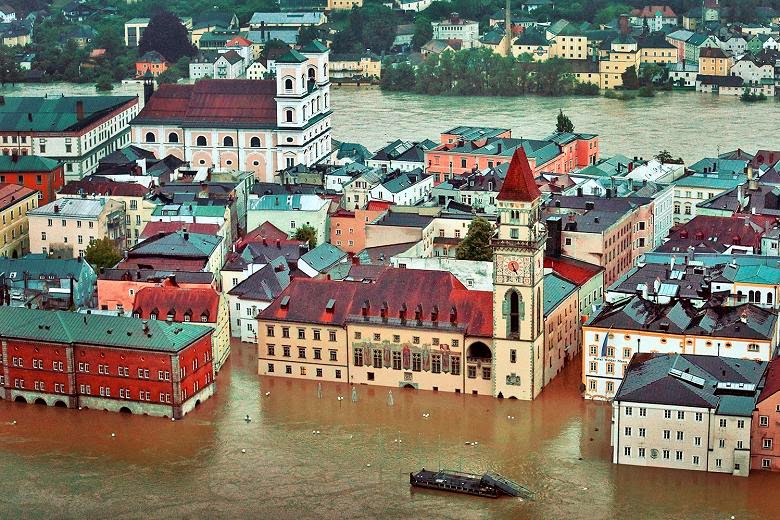The southern Bavarian city of Passau was originally established as the Roman colony, Batavia, in the second century B.C. The only thing that is this old in America is the average age of a Republican, so walking around this gorgeous city was heady, astounding, sobering, almost an out-of-body dissociate exercise. Just think to how long people have thrived their, how humanity and civilization has continued on there, in that one place for two millennia. Over two thousand years, before Jesus was born, people were there, evolving culture and society. In that ancient city whose history is prehistorical, I shopped and ate in many buildings that were built in the 13 century.
One of the most breath-taking things I saw in this nearly 2300 year old city was the St. Stephan’s Cathedral (just think—that church was there even before Jesus was born. No wait a minute.. never mind.) The interior of the church is Italian Baroque in style, replacing an ancient Gothic structure that was destroyed by fire in the seventeenth century. Passau has a rich church history. The St. Severinus monastery was established in Passau in the fifth century, and within two hundred years, the Passau Diocese had grown to become the largest diocese in the Holy Roman Empire. Currently, St. Stephen’s cathedral is the largest church downtown, and it is the church that my cousins, Martina and Florian, attend. The St. Stephen's Cathedral (Der Passauer Stephansdom) is in the the "Old City" (Die Altstadt) portion of town. The pipe organ at St. Stephen's has 17,774 pipes and 233 registers. It was the largest pipe organ in the world from 1924 until it was usurped in 1994 by the First Congregational Church, Los Angeles. You have heard that old joke about the guy streaking through the church, haven’t you? They caught him by the organ. Well at this church, that guy would be easy to catch. Its a really big organ. The one at the church, I mean.
Passau was established on the confluence of three rivers; the largest and most well known is the Danube, the other two are the Inn River and the Ilz River. The downside to this natural aquatic beauty is the propensity to flood. As a matter of fact, in June 2013, they experienced the worst flooding in 500 years. One of the buildings next to the river has painted markings documenting the floods. What is hard to see in the photo is the most recent flood is pencilled in, not painted on the building yet; so I added that with Fotor. (Flooding pics are from the internet, since I was not there at the time; otherwise all pics from this post are from my iPhone. I do not own these pics and if the owner reads this and objects to my using them, I will remove them).




I had the great pleasure of meeting two of my distant cousins who live in Passau. A third generation American, my German connections have long been lost, and it is only by the magic of the Internet and Facebook that I have been able to reconnect with quiet a few of my German relatives. Martina and Florian are fun, intelligent, warm and exceptionally hospitable. Meeting them was phenomenal, and I am blessed to count them as friends and relatives. We had coffee and pie at the Konditerei Simon. After that, we had a great walking tour of the city, and my Bavarian cousins, both Passau natives gave me a city ... isn't that about the coolest thing in the world? How often in life do you get a personal tour of a foreign city by cousins you just met for the first time? I have to say, this must surely be one of the highlights of my life. I do look forward to the day when I can show them around Chicago. After our walking tour, we ended the visit with coffee and a glass of wine at a amazingly charming cafe. We sat in the outside portion, in a courtyard in the center of the restaurant. We were surrounded by trellises with hanging plants. It was a cool fall evening in October, the air was fresh, the architecture surrounding us medieval Bavarian. The restaurant had thick fuzzy blankets to wrap up in while you enjoyed your hot beverage in the cool autumn air.
The city of Passau was breathtaking. It was never a surprise when I looked at a building and Martina would say “this was built in the 1200’s.” Amazing and awe-inspiring, but not a surprise. The centuries old building had a certain look and feeling to them, as if they have an aura themselves, speaking their own language about the centuries they have seen. The streets in the old part of town were cobblestoned and narrow, and overflowing with pedestrians. There were also many street vendors, entertainers and bicyclists. I saw people selling hot chestnuts, playing the French Horn, and putting on marionette shows.
One of the things that I found particularly amusing on my Bavarian tour, is that there is an Irish pub every town. Being half Irish and half German, I found particular personal delight in this. Who doesn't like an Irish pub, after all? Us Irish are loads of fun ... and so are we Bavarians. Considering the two halves of my heritage, its no wonder I seldom take life too seriously. Particular amusing to me was this Irish Pub in Passau, right next to a lederhosen shop. I could buy my lederhosen and go right next door for a Guinness, and celebrate the totality of my heritage in one fell swoop.
I could go back every year to Bavaria, and in particular, Passau. I hope to return with family and loved ones to share the experience.





















































